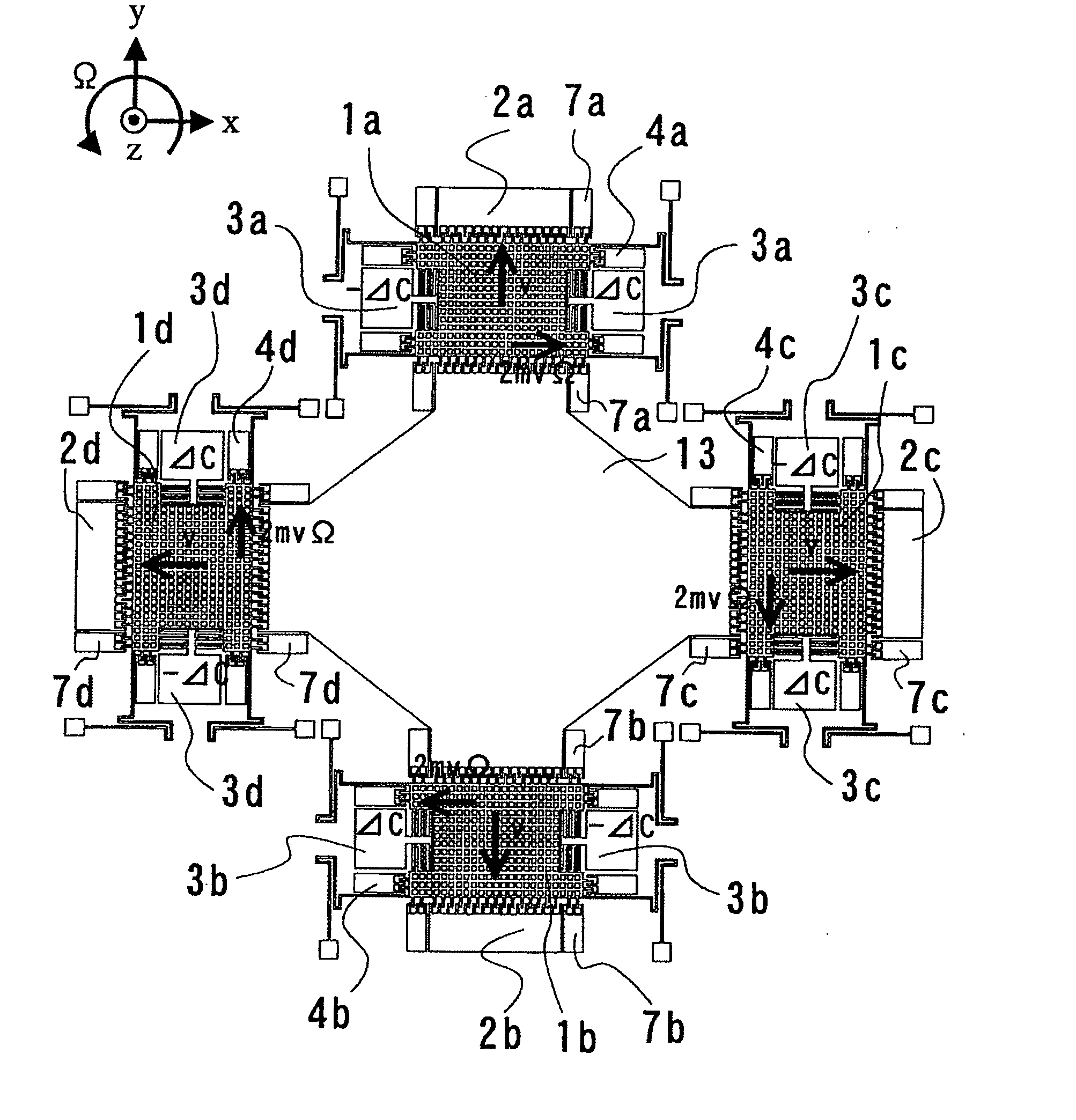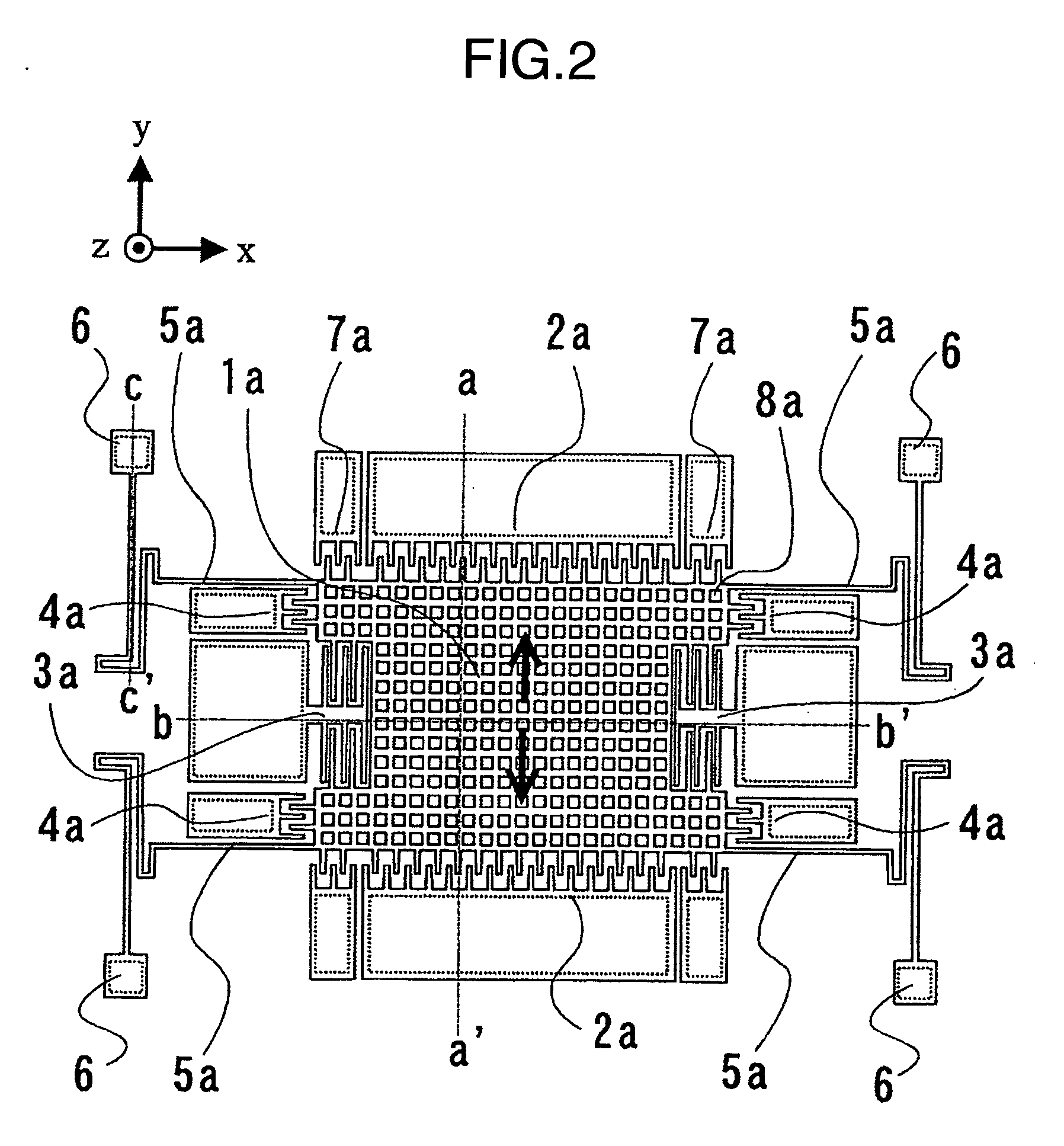Combined sensor and its fabrication method
a technology of combined sensor and fabrication method, which is applied in the direction of acceleration measurement using interia force, turn-sensitive devices, instruments, etc., can solve the problems of individual differences in the vibrational sensor elements, the publication does not disclose any combined sensor structure, and the inability to achieve the desired optimum vibrational characteristics, etc., to achieve the desired optimum vibration characteristics, improve the detection sensitivity of the sensor, and high tolerance to shock
- Summary
- Abstract
- Description
- Claims
- Application Information
AI Technical Summary
Benefits of technology
Problems solved by technology
Method used
Image
Examples
embodiment 1
[0031]FIG. 1 is a schematic diagram illustrating a sensor structure of a combined sensor according to the present invention. In FIG. 1, vibrating sensor elements 1a, 1b, 1c and 1d that are sensor elements constituting the combined sensor are shown. The vibrating sensor elements have the same structure. Accordingly, structure and operation of the combined sensor according to the present invention are now described with reference to the vibrating sensor element 1a.
[0032] The vibrating sensor element 1a is supported in the vibratile state in the x- and y-axis direction in the plane and in the z-axis direction outside of the plane by means of four springs 5a. This reason is that one ends of the springs 5a are connected to anchorages 6 constituting fixing parts connected to a supporting substrate. Other vibrating sensor elements 1b, 1c and 1d are also supported in the same manner. The vibrating sensor element 1a includes vibration generation means 2a disposed opposite to each other in t...
embodiment 2
[0057]FIG. 7 is a top view showing a vibrating sensor element 1a constituting a combined sensor according to a second embodiment of the present invention. The vibrating sensor element 1a is formed by dry-etching of a silicon-on-insulator (SOI) substrate in the same manner as that in the first embodiment. Different structure from the first embodiment is described. In the second embodiment, vibration separating plates 14a are disposed in order to separate the vibration in the x-axis direction and the vibration in the y-axis direction clearly. X-axis-directional spring beams 15ax that are springs in the x-axis direction and y-axis-directional spring beams 15ay that are springs in the y-axis direction are connected to the vibration separating plates 14a. As shown in FIG. 7, 4 x-axis-directional spring beams 15ax and 2 y-axis-directional spring beams 15ay are connected to one vibration separating plate 14a. Further, through-holes 8a are formed in the vibration separating plates 14a and a...
embodiment 3
[0060]FIG. 9 is a top view showing a vibrating sensor element 1a constituting a combined sensor according to a third embodiment of the present invention. The third embodiment is structured on the basis of the second embodiment. That is, the third embodiment includes the vibration separating plates 14a. The third embodiment is different from the second embodiment in that the detection means 3a of the comb structure formed in the vibrating sensor element 1a is removed and instead there are provided a pair of vibration adjustment means 4a disposed opposite to each other and 4 vibration detection means 7a disposed on the side of the vibration adjustment means 4a. Other structure is the same as that of the vibrating sensor element 1a of the second embodiment. Accordingly, the vibration principle of the vibrating sensor element 1a and the detection principle of the angular rate and the accelerations in the third embodiment are the same as the second embodiment. Four vibrating sensor eleme...
PUM
 Login to View More
Login to View More Abstract
Description
Claims
Application Information
 Login to View More
Login to View More - R&D
- Intellectual Property
- Life Sciences
- Materials
- Tech Scout
- Unparalleled Data Quality
- Higher Quality Content
- 60% Fewer Hallucinations
Browse by: Latest US Patents, China's latest patents, Technical Efficacy Thesaurus, Application Domain, Technology Topic, Popular Technical Reports.
© 2025 PatSnap. All rights reserved.Legal|Privacy policy|Modern Slavery Act Transparency Statement|Sitemap|About US| Contact US: help@patsnap.com



